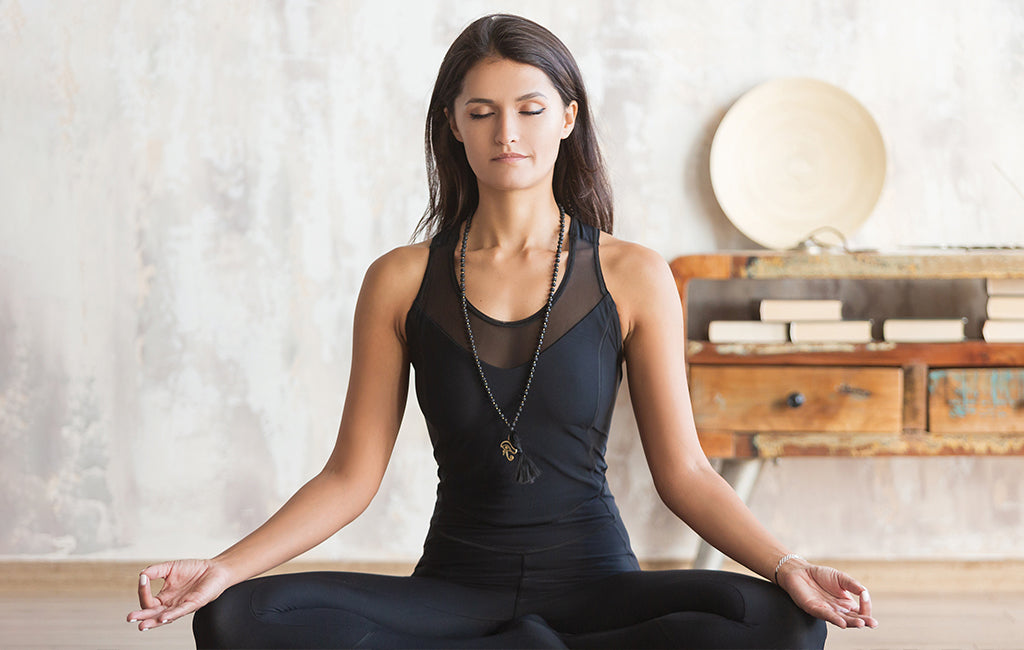
Meditation is a calming technique that trains your mind to achieve emotional calmness and a state of awareness through active mindfulness.
Like CBD oil, habitual meditation can help reduce stress, control irritability and improve your sleep. Meditating is also a great tool to decrease your blood pressure, lengthen your attention span and promote emotional health.
Ever wondered how many different styles of yoga there are? In many styles of yoga, yoga and meditation work together to achieve mind-body-spirit union at the beginning or end of each session. But you can also incorporate meditating into your yoga flow as you hold each yoga pose, too.
While no meditative practice is completely rigid, each type of practice has distinct qualities to achieve different results
Follow our guide to learn more about how to meditate during yoga.
How to Meditate
Successful meditation is all about mastering the mind to achieve inner peace. While meditation looks easy from the outside — sit down, take a deep breath and be silent — it can actually be quite difficult, especially for beginners.
If you plan to meditate before or after your yoga flow, following these steps:
- Find a comfortable area, then take a seat atop a yoga mat or cushion. You can keep your eyes open or close them.
- Set a timer for five to 30 minutes, depending on your experience level.
- Sit upright with your legs crossed. Take a moment to become aware of your body by wiggling your fingertips and toes.
- Draw focus to your breath. Become aware of how deeply you inhale and exhale, and how your body feels as it travels in and out of your body as you take a deep breath.
- It may help to count your breath, such as breathing in for four seconds, holding the breath for seven seconds and then breathing out for eight seconds to promote relaxation.
- Become an observer to your mind. Notice when it wanders, and accept it. Observe your thoughts and let them pass without engaging with them.
- Once you’re ready, gradually bring awareness back to your body. Gently lift your gaze and observe your environment, thoughts and emotions.
When you consider incorporating that practice into the fast-moving physical movements of yoga, it can seem somewhat contradictory. However, the most important aspect of meditation is the mind, which can be engaged whether you’re in a seated position or in a Downward Dog pose.
When performing a yoga meditation practice, follow these tips and tricks to achieve mindfulness:
- Keep your focus on the present moment — your breathing, your surroundings and how your body feels in each position, as well as where you need to make adjustments.
- Concentrate on deeply inhaling and exhaling through each pose, making sure you breathe consciously to support each position.
- Be aware of when your mind starts to wander and bring it back to focus with compassion.
- Maintain good posture throughout the flow, paying special attention to how the energy is moving through your body.
- Gaze at a single object such as a brick in the wall or a water bottle to refocus your mind if you’re holding a single position for a long duration of time.
Types of Meditation
A daily meditation practice can have significant benefits for your mental, emotional and physical health. Meditation gives you a moment to take a few deep breaths, separate yourself from the stresses of the world and focus your energy on yourself and your own healing.
When deciding which type of meditation you want to incorporate into your yoga routine, it’s important to note which types are available to you. While no meditative practice is completely rigid, each type of practice has distinct qualities to achieve different results, whether that’s mental calmness, positive emotions or self-reflection.
Actually, there are nine types of meditation you can incorporate into your yoga practice:
Mindfulness Meditation
This type of meditation originates from Buddhist teachings and aims to alter your consciousness to find awareness to achieve mind-body peace.
As you sit in meditation, observe your thoughts and identify patterns — but do not engage with them. Simply let them pass as if they’re floating down a river. When performing this type of mediation, it may also be beneficial to observe any bodily sensations or feelings that arise.
But essentially, you want to keep your mind as still and empty as possible.
Spiritual Meditation
Popular in Eastern religions like Hinduism and Daoism, those who practice spiritual meditation reflect on the silence around them to seek a deeper connection with the universe or other spiritual forces.
Oftentimes, this type of meditation is complemented with essential oils to heighten the experience, including:
- Sage
- Cedar
- Sandalwood
- Frankincense
Focused Meditation
Focused meditation involves focusing on one of the five senses during meditation: touch, sight, hearing, smell or taste. However, you can also concentrate on something internal, such as your breathing.
Some practitioners listen to gongs, count mala beads or stare at a candle flame. However, you can choose anything that works best for you. It’s often difficult to hold your focus for longer than a few minutes as the mind will start to wander. When this happens, be aware of it and refocus your mind back to your focal point.
Movement Meditation
Unlike traditional types of meditation, this type involves activity, such as taking a walk down a scenic path, planting roses in your garden or swimming a few laps in your pool. Of course, movement meditation is also a great counterpart to your yoga flow.
No matter your activity of choice, make sure it’s done with gentle movements and full awareness of what’s in front of you. This type of meditation is largely self-reflective and allows your mind to wander alongside you.
Mantra Meditation
Mantra meditation can be found in most Hindu and Buddhist teachings. Using a repetitive sound, such as “Om,” mantra meditation helps practitioners become more alert and in tune with their surroundings. It can also serve as a distraction to feelings of fear or irritability.
In addition to Om — which represents the sound of the universe — you can also chant other sacred words and phrases to match your intentions, such as:
- Om mani padme hum – Translating to “the jewel is in the lotus,” this mantra is used to transform impurity into purity, whether it’s your mind, body, speech or emotional state.
- Sat nam – Meaning “seed of wisdom,” this phrase is all about expressing your true self and increasing your consciousness to get to know yourself better.
- Ram – This mantra opens and cleanses your seven chakras to enhance your self-control and your self-esteem.
- Om namah shivaya – Most popular in yoga meditation practice, chanting this mantra helps to reach your highest self.
Transcendental Meditation
The purpose of transcendental meditation is to provide your mind with a space to relax inward. The practice promotes stress relief and a state of relaxed awareness similar to yoga poses for stress relief .
In fact, transcendental meditation is a lot like mantra meditation, in which you close your eyes and concentrate on a specific word or phrase. However, instead of chanting it aloud, you do it silently within your mind.
Transcendental meditation is so popular and widely researched that many schools and universities have incorporated the practice into their curriculum. In addition to a relaxed state of mind, transcendental yoga is also thought to lessen the risk of heart disease and reduce high blood pressure.
Progressive Relaxation Meditation
When working toward progressive relaxation, practitioners scan the body from the crown of the head to the soles of the feet to help reduce tension throughout the body and increase feelings of calmness.
As you scan your body, concentrate on certain areas by tightening and relaxing your muscles to increase bodily awareness. After scanning the body, visualize a calming wave sweeping through your body to release any additional strain or pressure you may feel.
Loving-Kindness Meditation
The purpose of loving-kindness meditation is to conjure feelings of compassion and acceptance toward yourself and others. It’s often thought of as a radical practice of unconditional love.
While you can go about this meditation in any way that’s most comfortable to you, most follow a script to guide them through:
- Receive loving-kindness: With your eyes closed, think of someone who loves you deeply. Feel them sending warm wishes and love your way.
- Send loving-kindness to loved ones: Picture someone you love, from the past or present. Repeat silently, “May you live with ease, may you be happy, may you be free from pain. May your life be filled with happiness, health and well-being.”
- Send loving-kindness to neutral people: Think of an acquaintance or someone you don’t know well. Repeat the same phrase silently three times.
- Send loving-kindness to all living beings: Expand your awareness to the global population. Again repeat the phrase three times.
Visualization Meditation
Imagine a scene vividly — it could be a place that brings you peace or a scenario you’re trying to manifest into existence. Imagine the smells, the sounds and the feelings, too.
Many use this type of meditation to imagine themselves achieving a goal or overcoming a personal hurdle. However, visualization meditation can also enhance feelings of inner peace, boost your mood and reduce stress.
Promote Inner Peace With Zebra CBD
Meditation and yoga work hand in hand to promote feelings of relaxation, improve your mood and relieve any tension stored in your body or mind. Through regular practice and focused concentration, meditation can significantly benefit your physical and psychological health.
Let Zebra CBD take your wellness one step further.
Our collection of premium CBD products can boost your mood and facilitate whole-body relaxation. Each of our products is made with the health-conscious yogi in mind — they’re free of heavy metals and unnatural herbicides and pesticides. Additionally, each product is tested by a third-party lab to ensure our labels are transparent and accurate.
Find whole-body wellness with Zebra CBD.
Source:
The Harvard Gazette. When science meets mindfulness. https://news.harvard.edu/gazette/story/2018/04/harvard-researchers-study-how-mindfulness-may-change-the-brain-in-depressed-patients/
Healthline. Which Type of Meditation is Right for You. https://www.healthline.com/health/mental-health/types-of-meditation










